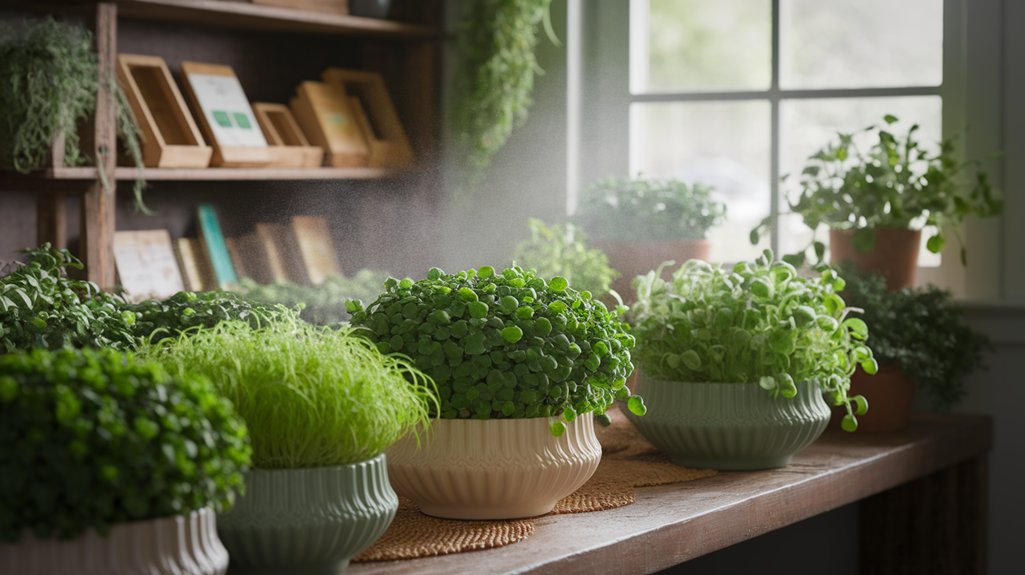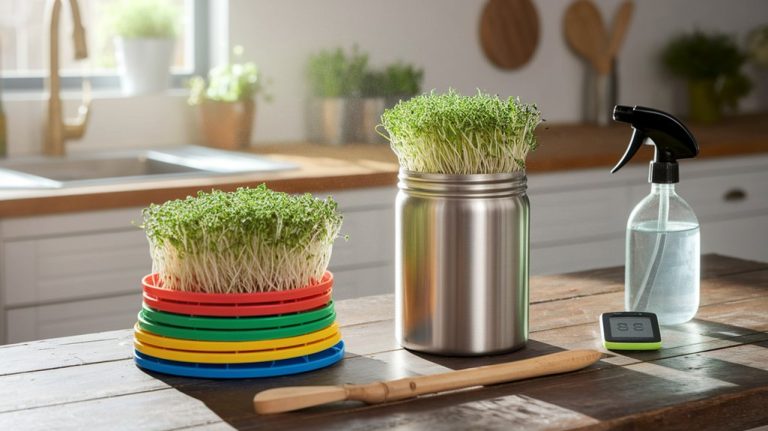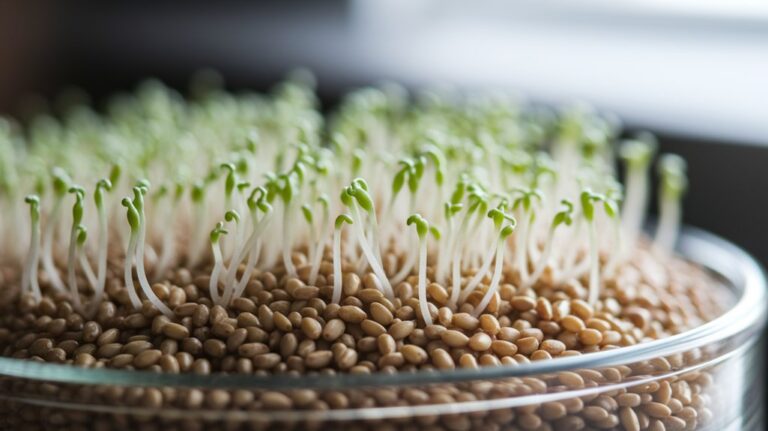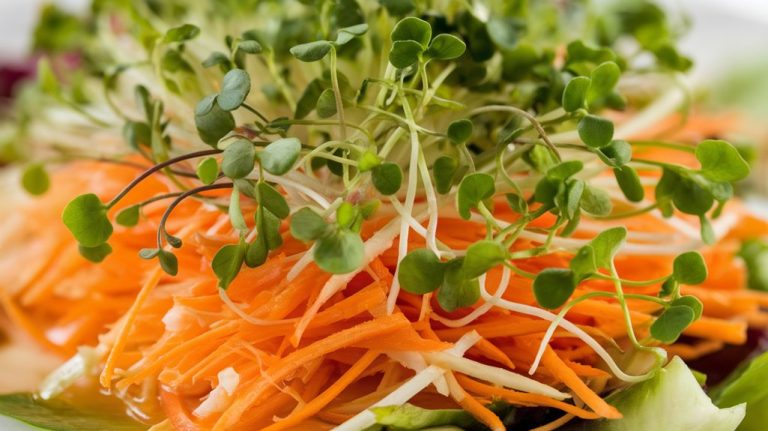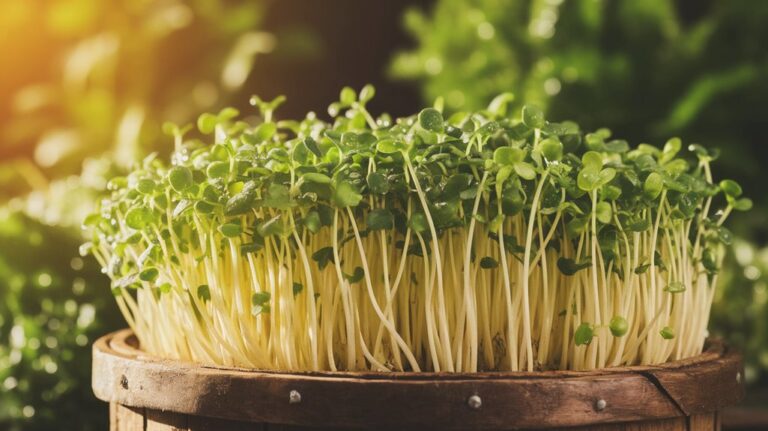Year‑Round Sprouting: How to Keep Fresh Greens in Every Season
I can keep fresh greens sprouting all year by creating optimal growing conditions, including moisture, warmth, and airflow. I choose organic seeds meant for sprouting, like alfalfa and broccoli, to ensure safety and better success. I rinse seeds 2-3 times daily and maintain a stable temperature of around 70°F. With direct but gentle light exposure after a few days, I can enjoy nutrient-dense sprouts in just 5-7 days. There’s so much more to explore on this journey!
Key Takeaways
- Select a variety of sprouting seeds to ensure a diverse supply of greens throughout the year, such as alfalfa, broccoli, and radish.
- Use a sprouting jar or tray with good airflow to prevent mold and ensure optimal conditions for year-round growth.
- Maintain ideal temperatures between 70-75°F (21-24°C) to promote consistent germination and growth of sprouts in any season.
- Rinse sprouts 2-3 times daily to keep them moist and prevent spoilage while ensuring proper drainage and airflow.
- Store harvested sprouts in breathable containers in the refrigerator, extending their freshness for up to a week.
Understanding the Basics of Sprouting
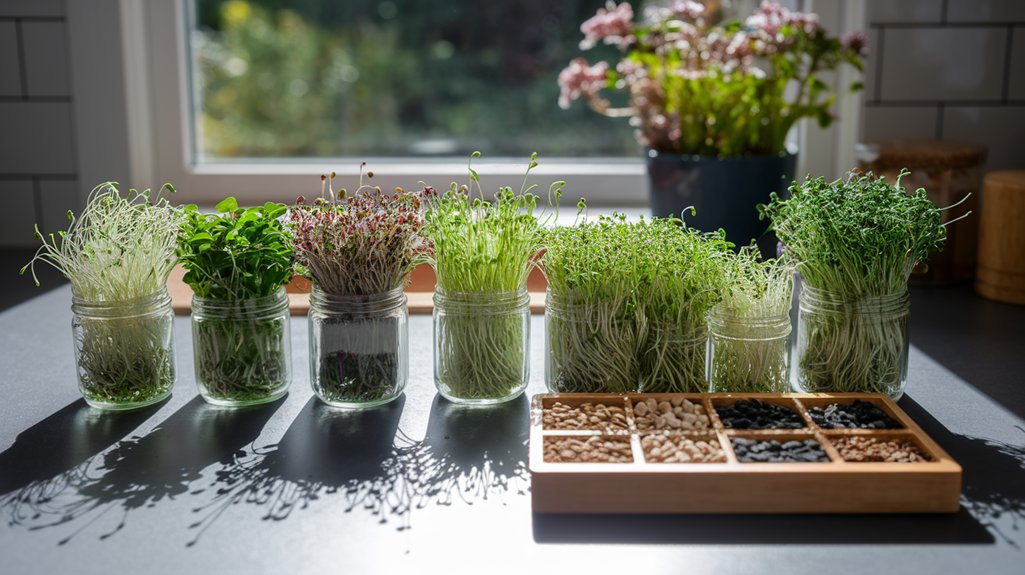
Although sprouting might seem like a simple process, it involves a fascinating interplay of biology and technique that can yield nutritious results. When seeds absorb water, they activate enzymes that kickstart germination. This process transforms dormant seeds into living plants, rich in vitamins, minerals, and enzymes.
I’ve found that maintaining optimal conditions—adequate moisture, warmth, and airflow—is crucial. Typically, I soak seeds for several hours, then rinse and drain them twice daily. This prevents mold and ensures even sprouting.
Temperature plays a vital role too; I aim for around 70°F (21°C) to create an ideal environment. Understanding these fundamentals not only enhances my sprouting success but also allows me to enjoy fresh greens throughout the year, regardless of the season.
Choosing the Right Seeds for Sprouting
How do I choose the right seeds for sprouting?
First, I look for seeds specifically labeled for sprouting, as these are tested for germination and free of contaminants. I prefer organic seeds since they’re grown without synthetic fertilizers or pesticides, ensuring a healthier crop.
Next, I consider the variety; popular choices include alfalfa, broccoli, and radish, each offering unique flavors and nutritional benefits.
I also check the seed size and shape, as some varieties may sprout faster than others.
Finally, I ensure the seeds are fresh, ideally within a year of purchase, to maximize sprouting success.
Essential Tools for Successful Sprouting
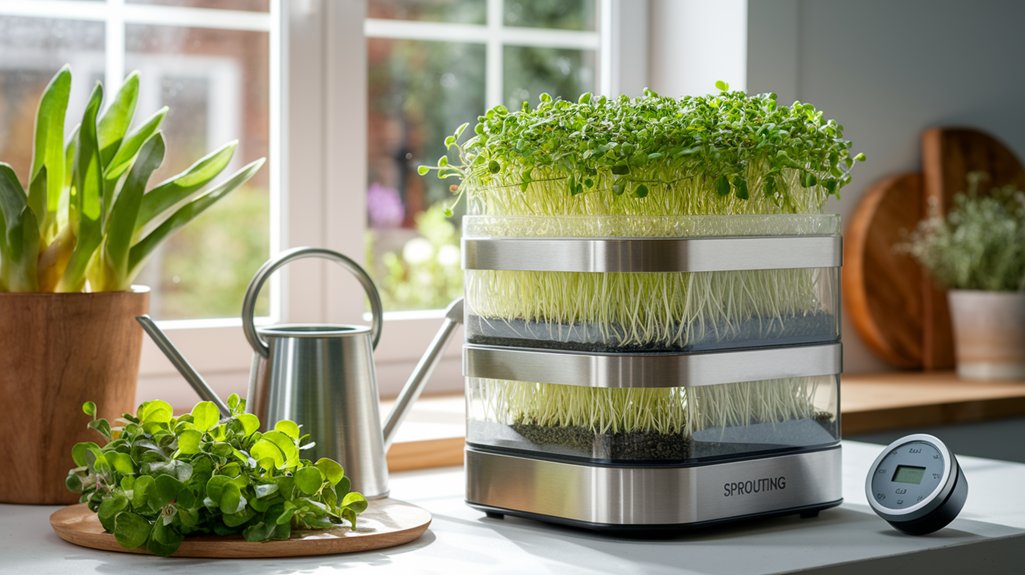
To successfully sprout seeds year-round, I rely on a few essential tools that streamline the process and enhance my results.
First, a high-quality sprouting jar with a mesh lid allows for optimal airflow and drainage. I also use a dedicated sprouting tray for larger seeds, which provides ample space and drainage.
A fine-mesh sieve is essential for rinsing seeds effectively, ensuring they receive the moisture they need without becoming waterlogged. Additionally, a thermometer helps me maintain the ideal temperature for germination.
Finally, having a spray bottle handy ensures I can mist my sprouts gently, keeping them hydrated without over-saturating.
With these tools, I consistently achieve healthy, vibrant sprouts throughout the year.
Step-by-Step Guide to Sprouting at Home
When I sprout at home, I start by selecting the right seeds, as not all seeds are suitable for sprouting.
I also gather essential equipment, like jars or sprouters, to ensure optimal growth conditions.
Finally, I focus on maintenance and care, which are crucial for achieving healthy, vibrant sprouts.
Choosing Sprouting Seeds
While selecting the right seeds for sprouting may seem straightforward, it’s crucial to ensure they’re specifically labeled for sprouting to guarantee safety and viability.
Here are some key factors I consider when choosing my sprouting seeds:
- Source: I always buy seeds from reputable suppliers who specialize in sprouting seeds.
- Variety: I opt for a range of varieties like alfalfa, broccoli, and radish to diversify my nutrient intake.
- Non-GMO: I prefer non-genetically modified seeds to ensure a healthier product.
- Organic: Whenever possible, I choose organic seeds to avoid pesticides and support sustainable practices.
Essential Sprouting Equipment
Having the right equipment is essential for successful sprouting at home.
First, I recommend a sprouting jar, which allows for optimal air circulation and drainage. A fine mesh lid is crucial to prevent seeds from escaping while allowing water to flow freely.
Next, consider a sprouting tray if you prefer larger quantities; these trays provide ample space for growth.
You’ll also need a clean, filtered water source to rinse and hydrate your seeds effectively. A thermometer can help monitor the ideal temperature, while a light source can promote healthy growth during darker months.
Lastly, a sharp pair of scissors is handy for harvesting your fresh greens.
With this equipment, I can sprout successfully and enjoy fresh greens year-round.
Maintenance and Care Tips
Successful sprouting relies heavily on consistent maintenance and care throughout the process. To ensure your sprouts thrive, I follow these essential steps:
- Rinse Regularly: I rinse my seeds 2-3 times a day to keep them moist and prevent mold. This step is crucial for healthy growth.
- Monitor Temperature: I keep my sprouting jar in a warm, dark place, ideally between 70-75°F. This temperature range promotes optimal germination.
- Adjust Light Exposure: After a few days, I place my sprouts in indirect sunlight for a few hours daily, enhancing their nutritional content.
- Harvest Promptly: I harvest my sprouts within 5-7 days. They’re best consumed fresh, maximizing flavor and nutrition.
The Best Types of Sprouts for Year-Round Growth
When I choose sprouts for year-round growth, I focus on nutrient-dense options like broccoli and lentils, which pack a punch of vitamins and minerals.
Fast-growing favorites, such as alfalfa and radish sprouts, not only sprout quickly but also add a crisp texture to my dishes.
Nutrient-Dense Options
Although many sprouts offer significant health benefits, some varieties stand out for their exceptional nutrient density and ability to thrive year-round.
When I choose sprouts for my indoor garden, I prioritize these four nutrient-dense options:
- Broccoli Sprouts: Packed with sulforaphane, they’re known for their cancer-fighting properties.
- Mung Bean Sprouts: Rich in vitamins A, C, and K, they support immune function and skin health.
- Alfalfa Sprouts: High in antioxidants and fiber, they promote digestive health and lower cholesterol.
- Radish Sprouts: Containing glucosinolates, they aid in detoxification and have antimicrobial properties.
Fast-Growing Favorites
While many sprouts can flourish indoors, I’ve found that certain varieties not only grow quickly but also provide a continuous supply of fresh greens throughout the year.
My top fast-growing favorites include alfalfa, which sprouts in just 3-5 days, and radish sprouts, known for their peppery flavor and readiness in about 5-7 days.
Broccoli sprouts are another excellent choice, rich in sulforaphane, taking only 5-6 days to mature.
For a crunchy texture, I recommend mung bean sprouts, sprouting in 4-6 days.
Each of these sprouts thrives in minimal light and requires simple care, making them perfect for year-round cultivation.
With these options, you can enjoy fresh, nutrient-rich greens regardless of the season.
Maintaining Optimal Conditions for Sprouting
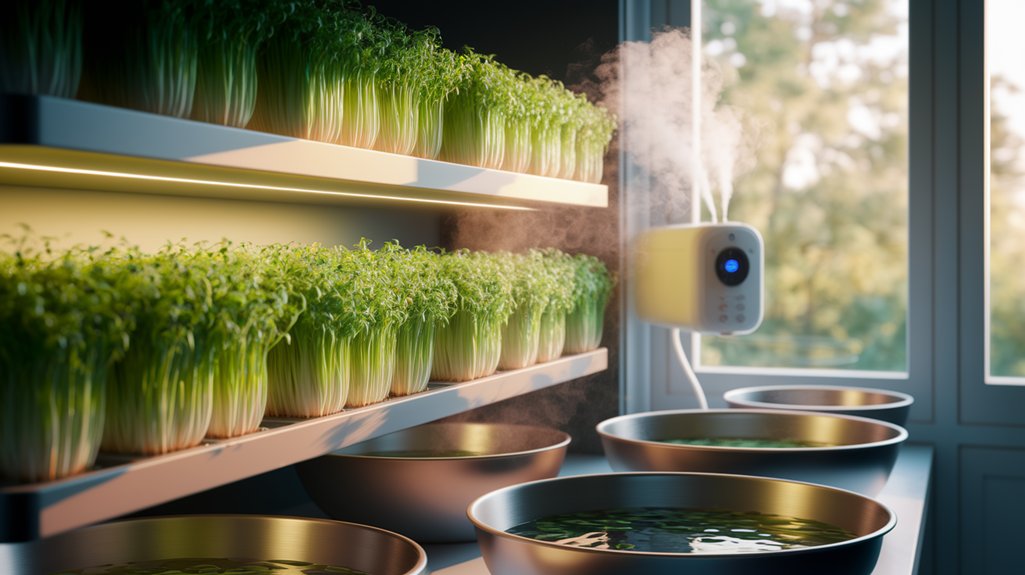
Maintaining optimal conditions for sprouting is crucial to achieving healthy and robust growth.
I’ve found that focusing on key environmental factors can make a significant difference. Here are four essential conditions to monitor:
- Moisture: Ensure seeds are consistently damp but not waterlogged. Too much water can lead to rot.
- Temperature: Aim for 65-75°F (18-24°C) for most seeds, as warmth encourages germination.
- Light: Provide indirect sunlight or artificial light for 12-16 hours daily, promoting photosynthesis and growth.
- Air Circulation: Good airflow prevents mold and mildew—consider using a fan or proper ventilation.
Troubleshooting Common Sprouting Issues
Have you ever encountered stubborn seeds that just won’t sprout? It can be frustrating, but troubleshooting common sprouting issues is key.
First, check your seeds’ age; old seeds often have lower germination rates. Next, ensure proper soaking times. Some seeds need longer soaking periods, while others can rot if soaked too long.
If your sprouts seem moldy, it might be due to excessive moisture or inadequate airflow. Rinse your seeds regularly to prevent this.
Temperature plays a crucial role too; seeds generally prefer a warm, stable environment.
Lastly, consider the light exposure; while sprouts don’t need direct sunlight initially, they do require adequate light once they begin growing.
Addressing these issues promptly can lead to successful sprouting!
Incorporating Sprouts Into Your Meals
Incorporating sprouts into your meals can elevate both the nutritional value and the flavor profile of your dishes. I love adding them to my meals for their crunch and health benefits.
Here are a few ways I do it:
- Salads: Toss a handful of alfalfa or broccoli sprouts into your salads for a fresh, zesty kick.
- Wraps: Layer sprouts in wraps with hummus, veggies, and proteins for added texture and nutrition.
- Soups: Sprinkle a few radish sprouts on top of soups just before serving for a peppery flavor enhancement.
- Smoothies: Blend mild sprouts like pea shoots into smoothies for an extra nutrient boost without altering the taste significantly.
These simple additions can transform your meals and promote healthful eating year-round!
Storage Tips for Fresh Sprouts
When it comes to storing fresh sprouts, I’ve found that maintaining ideal conditions is crucial for preserving their freshness and nutritional value.
I recommend using breathable containers, like mesh bags or perforated plastic containers, to ensure proper airflow while preventing excess moisture.
Generally, sprouts can last about 5 to 7 days in the refrigerator, so it’s important to keep an eye on their condition to maximize their shelf life.
Ideal Storage Conditions
While I understand that fresh sprouts can add a nutritious crunch to meals, proper storage is crucial to maintain their freshness and safety. Here are my ideal storage conditions to keep your sprouts vibrant:
- Temperature: Store sprouts in the refrigerator at temperatures between 34°F and 40°F (1°C to 4°C) to slow down spoilage.
- Humidity: Keep them in a slightly humid environment; too dry will wilt them, but too wet can promote mold.
- Airflow: Use breathable containers to ensure proper airflow, preventing condensation that leads to spoilage.
- Duration: Consume fresh sprouts within 3 to 7 days for peak freshness; older sprouts lose their nutritional value and taste.
Recommended Storage Containers
Choosing the right storage container can significantly impact the freshness and longevity of your sprouts. I recommend using glass jars with breathable lids or mesh tops, as they allow for air circulation while preventing excess moisture.
If you prefer plastic, opt for BPA-free containers with ventilation holes. These materials help minimize the risk of mold growth and preserve the delicate textures of your sprouts.
Additionally, consider using airtight containers for short-term storage in the refrigerator. However, be cautious not to pack them too tightly; sprouts need some space to breathe.
For longer storage, vacuum-sealed bags can extend freshness, but ensure they’re not overly compressed. Experiment with these options to find what works best for your sprouts, ensuring they stay vibrant and nutritious.
Shelf Life Guidelines
Fresh sprouts typically maintain their best quality for about 5 to 7 days when stored properly in the refrigerator.
To maximize their shelf life, I recommend following these guidelines:
- Keep Them Dry: Excess moisture can lead to mold. I always ensure my sprouts are well-drained before storage.
- Use Airtight Containers: I opt for glass jars or plastic containers with tight lids to minimize air exposure.
- Store in the Fridge: I place my sprouts in the crisper drawer, where temperatures are more stable.
- Check Regularly: I inspect my sprouts every few days for any signs of spoilage, removing any affected ones immediately.
Exploring the Health Benefits of Sprouts
Have you ever considered how incorporating sprouts into your diet can enhance your overall health?
Sprouts are nutrient-dense powerhouses, packed with vitamins, minerals, and antioxidants. They boast higher concentrations of nutrients compared to their mature counterparts, making them ideal for boosting your immune system and improving digestion.
For instance, alfalfa sprouts are rich in vitamin K, which supports bone health, while broccoli sprouts contain sulforaphane, known for its cancer-fighting properties.
Additionally, the high fiber content in sprouts aids in weight management and promotes gut health by supporting beneficial bacteria. Their low calorie count makes them a perfect addition to salads, sandwiches, or smoothies.
Frequently Asked Questions
Can I Sprout Seeds Without Sunlight?
Yes, you can sprout seeds without sunlight. I’ve done it many times!
By soaking the seeds and then placing them in a dark, warm environment, they’ll germinate just fine. I typically use a jar with a mesh lid for ventilation.
Keep them moist but not soaking wet, and in a few days, you’ll see tiny sprouts emerging.
Just remember, once they’re ready, they’ll benefit from some light to grow stronger.
How Long Do Sprouts Typically Last in the Fridge?
Sprouts typically last about 5 to 7 days in the fridge if stored properly.
I always make sure to rinse them gently and place them in an airtight container lined with a damp paper towel. This keeps them fresh and prevents excess moisture, which can lead to spoilage.
I recommend checking them daily for any signs of sliminess or odor, as that indicates it’s time to discard them.
Enjoy your fresh sprouts!
Are There Any Seeds That Shouldn’t Be Sprouted?
When it comes to sprouting seeds, not all are safe or suitable. I’ve learned that seeds from the nightshade family, like tomatoes and eggplants, can be toxic when sprouted.
Additionally, certain beans, like kidney beans, contain harmful lectins that can cause digestive issues if not cooked properly.
I always stick to seeds specifically labeled for sprouting to ensure safety and avoid any unpleasant surprises in the process.
How Often Should I Rinse My Sprouts?
I rinse my sprouts two to three times a day to keep them fresh and prevent mold. Each time, I use fresh, cool water to gently wash them, ensuring that all the seeds and sprouts are thoroughly rinsed.
After rinsing, I let the excess water drain well. This routine helps maintain moisture levels while promoting healthy growth.
Keeping an eye on their appearance also guides me on when to adjust the rinsing frequency.
Can I Sprout Seeds in Soil Instead of Jars?
Yes, I can sprout seeds in soil instead of jars.
When I use soil, I ensure it’s well-draining and nutrient-rich, providing a suitable environment for sprouting. I lightly sprinkle the seeds on the surface and gently cover them with a thin layer of soil.
I keep the soil moist but not waterlogged, and I place it in a warm area with adequate light. Monitoring moisture levels is key to successful sprouting in soil.
Conclusion
Incorporating year-round sprouting into your routine not only ensures a constant supply of fresh greens, but also enhances your meals with vibrant flavors and essential nutrients. By mastering the basics of sprouting, choosing the right seeds, and utilizing the proper tools, you can enjoy the benefits of homegrown sprouts regardless of the season. With a little practice and attention to detail, you’ll find sprouting to be a rewarding and healthful endeavor that elevates your culinary experience.

